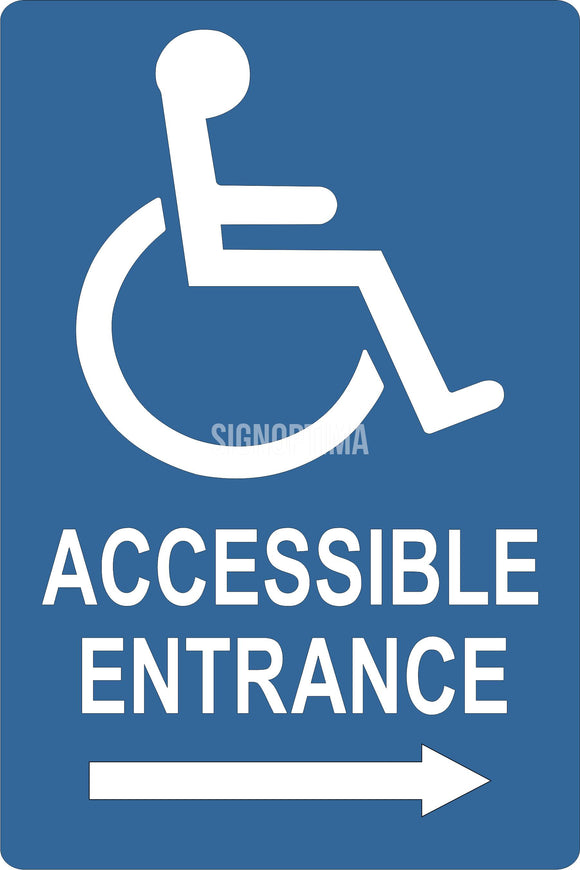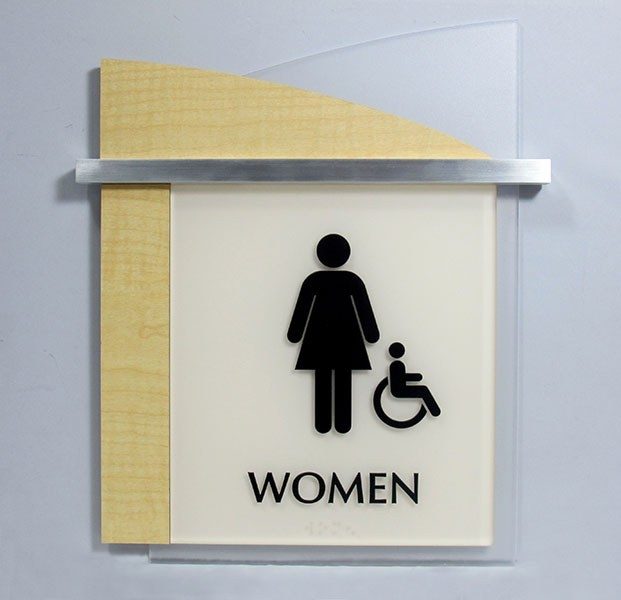ADA Signs: Crucial Tools for Inclusive Environments
ADA Signs: Crucial Tools for Inclusive Environments
Blog Article
Exactly How ADA Signs Transform Areas for People With Specials Needs
The improvement of areas with ADA indicators for individuals with specials needs is a profound testament to the power of availability. By adhering to ADA compliance, atmospheres become accessible and secure, with indicators that feature important components like high-contrast colors and Braille, consequently boosting exposure and understanding. Past simple functionality, these indications add to neighborhood addition, providing a sense of empowerment and belonging. As we look in the direction of future patterns in easily accessible signage, one must take into consideration how advancing modern technologies might better transform these rooms. What obstacles and opportunities exist ahead in ensuring these areas stay inclusive for all?

Importance of ADA Compliance
Making sure ADA conformity is not only a legal responsibility but likewise a societal dedication to inclusivity and access. By sticking to the guidelines stated in the Americans with Disabilities Act (ADA), companies demonstrate their dedication to developing atmospheres where individuals with specials needs can involve and navigate without barriers. ADA conformity is important in removing discrimination, promoting equal rights, and promoting freedom for people with impairments.
Organizations and public organizations profit significantly from ADA conformity. By making sure facilities are obtainable to every person, companies can bring in a broader customer base, including the 61 million Americans living with handicaps.
Additionally, ADA conformity is a keystone of universal design, which stresses producing areas that accommodate all people, despite their capabilities. By executing compliant signage and features, organizations add to a more equitable culture, where all participants can get involved totally. Ultimately, ADA compliance goes beyond legal responsibility, personifying a societal worth that focuses on empowerment and level playing field for every person.
Enhancing Navigating and Security
Browsing rooms with confidence and safety and security is important for individuals with specials needs, and ADA-compliant signage plays an essential duty in achieving this objective. These indications are developed with specific attributes to deal with the diverse needs of people with numerous disabilities, thereby helping with smoother and more secure navigating throughout public and private areas. By providing clear, standardized information, ADA signs lessen confusion and advertise a higher feeling of self-reliance for individuals that rely upon them.
The strategic placement of ADA signs guarantees that necessary details comes to everybody, consisting of those with aesthetic, auditory, or cognitive disabilities. As an example, responsive and Braille components on indicators assist aesthetically impaired people individually situate leaves, toilets, and other key areas. In emergency situations, ADA signs add to efficient discharges by clearly noting emergency departures and courses, thus enhancing security for all residents.
Moreover, ADA-compliant signs cultivate a comprehensive setting by dealing with the unique navigation obstacles faced by people with disabilities. This not only help in their individual safety and security but likewise urges engagement in social activities by promoting equal access to civil services and facilities. Inevitably, efficient ADA signage changes rooms right into accessible, secure, and inviting settings for every person.
Functions of Reliable ADA Signs
To develop effective ADA indicators, it is essential site to include details features that attend to the varied availability demands of people with impairments. One essential attribute is making use of high-contrast colors, which considerably boost presence for individuals with aesthetic impairments. The history and text ought to contrast dramatically to guarantee the details is quickly discernible. Furthermore, the text has to remain in a sans-serif font style, as these fonts use more clear readability at a range.
Another important function is responsive elements, such as elevated characters and Braille, facilitating access for visually damaged individuals. The elevated characters should go to least 1/32 inch over the surface, permitting for very easy touch analysis. Braille should be positioned straight listed below corresponding text, guaranteeing uniformity and simplicity of navigating.
The positioning of ADA indicators is also essential for their effectiveness. By integrating these functions, ADA indications can substantially boost wayfinding and access for all.
Influence on Community Inclusion
ADA signs significantly add to neighborhood addition by ensuring that public rooms are navigable and accessible for people with click reference handicaps. These signs, made in conformity with the Americans with Disabilities Act (ADA), function tactile elements, braille, and high-contrast colors, assisting not just those with visual disabilities however a varied array of specials needs - ADA Signs. Consequently, they play a pivotal function in creating atmospheres where people with specials needs can get involved fully and separately in community life

Furthermore, ADA indications aid businesses and organizations meet legal responsibilities, consequently protecting against prospective discrimination lawsuits and boosting their track records as inclusive entities. Inevitably, ADA indications are important tools in the recurring effort to construct more fair and easily accessible neighborhoods for everyone.
Future Trends in Accessible Signs
The integration of innovative technologies assures to revolutionize exactly how individuals with handicaps connect with their environments. Electronic indications geared up with sensing units and connectivity can interact with personal tools to offer customized info, such as text-to-speech for visually impaired users or simplified graphics for those with cognitive disabilities.
Augmented truth (AR) also holds considerable capacity. AR applications can overlay electronic info onto real-world environments, offering individuals with enhanced navigational help and contextual details (ADA Signs). This can be especially advantageous in complicated setups like airports or big public places where standard signs might fail
Another arising trend is the consolidation of Web of Points (IoT) technology to develop a network of interconnected indications. This allows for real-time updates and enhanced availability, adapting to changes in the setting or individual requirements. Furthermore, with the expanding emphasis on inclusivity, future laws may promote a lot more sophisticated signs remedies, making sure universal gain access to and cultivating a much more inclusive culture for all people.
Final Thought
ADA indicators play an important role in transforming spaces for individuals with impairments by making sure accessibility and promoting freedom. Compliance with ADA standards boosts navigation and security through the usage of high-contrast colors, tactile elements, and Braille.
The improvement of spaces via ADA indicators for individuals with handicaps is an extensive testament to the power of access.To create reliable ADA signs, it is critical to include certain functions that address the diverse accessibility needs of people with handicaps.ADA signs substantially contribute to community inclusion by making certain that public spaces are easily accessible and accessible for individuals with handicaps.By facilitating the simplicity of movement and understanding within public rooms, ADA indications foster a sense of belonging and empowerment among people with handicaps.ADA indicators play an important role in changing spaces for individuals with handicaps by ensuring ease of access and promoting self-reliance.
Report this page